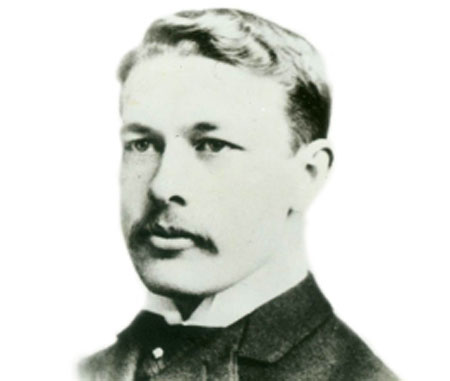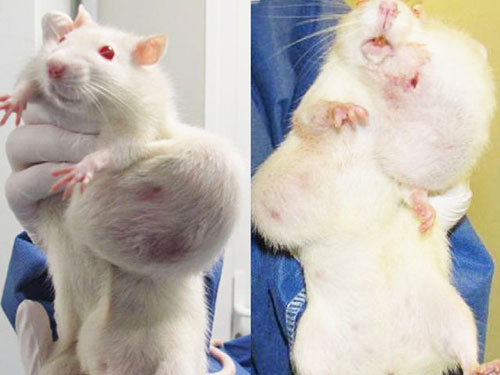Coley’s Dramatic Cancer Cure: Why Does His Method Work?
In the late 1800s, surgery was really the only decent option available to cancer patients. This frustrated Dr. William B. Coley, especially after he was unable to save a patient. So, in 1891, inspired by a case he’d read about, Coley decided to try something new.

He used bacteria to purposely infect a New York City man named Zola, who had many advanced tumors including one in his throat that prevented him from eating. Amazingly, it worked, and soon after Zola resumed his normal life.
For many reasons, including the advent of radiation and then chemotherapy, Coley’s approach was largely dismissed during his lifetime. Immunotherapy would not be forgotten though.
In 1953, Coley’s daughter Helen published 30 documented cases of cancer patients that were cured by the method of her father. She wrote a long article (which later was published as a book) in Acta Medica Scandanvia entitled A Review of the Influence of Barcterial Infection and of Bacterial products (Coley’s Toxins) on Malignant Tumors in Man. Her co-authors were George Fowler, MD and Frances Bogatko, MD.
The rest of this article is taken from the Introduction to that book:
“The treatment of cancer by injections of bacterial products is based on the fact that for over two hundred years neoplasms have been observed to regress following acute infections, principally streptococcal.
If these cases were not too far-advanced and the infections were of sufficient severity or duration, the tumors completely disappeared and the patients remained free from recurrence.
If the infections were mild, or of brief duration, and the neoplasms were extensive or of histological types which were less sensitive to infections or their toxins, only partial or temporary regressions occurred.
Of all the many investigators who studied this phenomenon, the late William B. Coley, M. D. is the only one who devoted a lifetime to the subject. His search for a systemic treatment of cancer began in the first year of his practice (1891) when he lost his first patient (suffering from a bone sarcoma) in spite of early, radical and repeated surgery. This led him to study all the cases of sarcoma treated in the New York Hospital during the preceding 15 years.
His interest in the possible therapeutic value of infections or their toxins was aroused by one of the cases in this series of histories — a thrice-recurrent inoperable sarcoma of the neck, in which five operations had failed to control the disease. This patient recovered after two attacks of erysipelas and remained free from further recurrence seven years later.
Beginning in May 1891, Coley attempted to produce erysipelas in a twice- recurrent inoperable myxosarcoma of the tonsil and neck. After repeated trials, using four different cultures, he succeeded. The resulting severe erysipelas caused complete regression of the tumors except for cicatricial tissue from the former operations.
After attempting to induce erysipelas in nine other patients, Coley recognized the difficulties — either the patient might prove immune, or the infection fatal. He tried cultures of erysipelas sterilized by heating or by filtration, but these proved weak and ineffective.
In December 1892, he learned of the investigations of Roger on bacillus prodigiosus (Serratia marcescens) in association with other micro-organisms. These experiments suggested that bacillus prodigiosus or its toxins may increase the virulence of other organisms with which they are associated in their proliferating stage.
Coley therefore decided to mix the toxins of bacillus prodigiosus with those of, erysipelas in order to increase the virulence of the latter. The first “Coley Mixed Toxins” were sterilized by filtration, and the first case treated by this preparation was a bedridden young man with an inoperable sarcoma of the abdominal wall and pelvis, involving the bladder. The extensive growth disappeared and the patient remained free from recurrence until his sudden death in a subway station from heart disease, 26 years later.
The preparation then in use, however, was variable and not potent enough to produce cures in the more resistant types of neoplasms. Limited space prevents a detailed description of the more than 15 different formulae of Coley’s toxins used in the past 60 years. Suffice it to say that it was not until the more potent unfiltered Buxton and Tracy preparations were available and were intelligently administered that the more resistant types of cancer were successfully treated.
During the past 14 years we have been making a critical analysis of toxin therapy. The approach has been much more fundamental than merely to study the historical background of Coley’s Toxins. The goal has been to gather available data on the effects of acute infections or their metabolites, and various forms of inflammation on malignant disease.
This includes: the beneficial effects of one intercurrent disease upon another; the effects of pyogenic, non-pyogenic or non-pathogenic bacteria or their toxins or enzymes; the effects of viruses; the effects of various inflammatory or antibiotic substances; the effects of physiotherapeutic or chemotherapeutic agents of non-bacterial origin; and all known cases in which so-called “spontaneous regressions” occurred.
Many of the questions relating to this study have received little consideration. For example, why is it that the incidence of cancer has increased much more rapidly since the advent of modern asepsis and public health than ever before?
…We believe this is because these technics have sharply reduced the incidence of surgical infections and infectious diseases. Shear, of the National Cancer institute, seems to agree with us, for in 1950 he observed that 75 per cent of the spontaneous remissions in untreated leukemia in the Children’s Hospital in Boston occurred following an episode of acute disease.
He asks: “Are pathogenic and non-pathogenic organisms one of Nature’s controls of microscopic foci of malignant disease, and, in making progress in the control of infectious diseases, are we removing one of Nature’s controls of cancer?”
Jacobsen (1934) cited data which he claimed represented the uniform observations of experienced clinicians with reference to the low incidence of malignant disease in patients who had been victims of a common infectious process, i.e., in the actively tuberculous or osteomyelitic, and in patients with acute infections diseases in general, particularly those giving a history of typhoid, paratyphoid, scarlatina or diphtheria.

Jacobsen concluded that the evidence tends to support the conclusion that the reticulo-endothelial system when sufficiently active, (as when stimulated by one or a number of infectious processes) may attain in a measure the ability to cope with neoplastic diseases in a similar, if not identical manner.
He also believes that the present increase in malignant morbidity is due to the decreased resistive powers of the reticulo-endothelial system occasioned by the lessened incidence of exposure to and infection of the general public with those diseases which were widely endemic before the advent of modern public health methods.
He believed that as acromegaly is a disease of the pituitary, so cancer should be regarded as a disease of the reticulo-endothelial system, and the hope of prevention and cure lies in toxin therapy.
In an editorial in the J.A.M.A. (1934) this whole matter was discussed and it was concluded that further studies in this field seemed indicated in the light of the accumulated evidence.
As to experimental work which may support this theory, Teutschlander has demonstrated a definite decrease in the susceptibility of tuberculous fowls to Rous chicken sarcoma, and Bashford found mice convalescent from contagious diseases were refractory to tumor transplants.
Shwartzman reviewed the literature bearing on the effects of intercurrent infections on animal tumors. [Arch. Path.21. 284-297. 1936]
Many physicians believe that the chief therapeutic value of toxin therapy lies in the fever produced.
It appears that these early physicians induced inflammation at the site of the neoplasm by a variety of methods, while at the same time they stimulated the organism as a whole, and that they persisted with the treatments for many months, changing the remedies as tolerance developed.
In studying all these apparently unrelated older and more recent approaches to the cancer problem, one finds they have certain points in common: a more or less severe local inflammation, produced by an irritating or destructive agent such as radiation, diathermy, intratumoral injections of toxins, acute local infection, poultices, leeches or vesicants, occurring either alone or combined with a profound systematic stimulus.
The systemic stimuli were produced by various means such as Coley’s toxins or other bacterial or plant products injected remote from the tumor by the intramuscular, intraperitoneal or intravenous route, or by the systemic effects of severe bacterial infections.
In addition to the above, cases were in which spontaneous remissions occurred following an intercurrent fracture, burn, shock or absorption of extensive pleural effusion, or ascites. In all these cases there also appeared to be both inflammation and a systemic stimulus such as fever or “stress”.
Of all these combinations, the largest number of successful results have occurred in two groups: a) in cases of malignant disease in which an acute erysipelas infection developed in or near the tumor; b) in cases treated by Coley’s toxins, where a reasonably potent product was administered both into the tumor or its immediate periphery (to induce local inflammation and sensitize the tumor cells) and also remote from the tumor, in doses sufficient to elicit marked systemic reactions, fever and chills, the injections being continued until after the growth had disappeared in order to prevent recurrence or metastases.
The results in patients with inoperable neoplasms so treated were uniformly good.
We do not include terminal cases in this category, although some of these also responded dramatically.
Jacobi’s work with bacterial filtrates (B. typhosus) on several types of animal tumors emphasizes the importance of sensitizing tumors by intratumoral injections. He elicited violent hemorrhagic and necrotic reactions followed by either complete sloughing and healing or by slow recurrence of tumor growth which again responded to further injections.
This occurred in all the animals in which the tumor tissue was first “prepared” or sensitized by an intratumoral injection followed by an intravenous or intraperitoneal injection. In the controls in which saline was substituted or in which the filtrate was injected only intratumorally or only intraperitoneally, these effects were not obtained, and the tumors continued to grow, causing death of the animals.

Duran Reynal’s more extensive studies bearing on this problem were discussed in some detail in two of our earlier publications. These findings may have an important bearing on planning the optimum technic of administration for treating human cancer.
Although Fogg observed inhibition of growth of sarcoma 180 cells in tissue culture with certain bacterial products, it was not generally recognized that bacterial toxins do not actually kill cancer cells in vitro although they cause regression of cancer in vivo.
This would seem to be a further indication that much of their curative action must be exerted indirectly, through stimulating the body’s basic defense mechanisms (inflammation, alarm reaction, fever, etc). However, both heat and inflammatory exudates do destroy neoplastic cells in vitro, as well as causing regression of neoplasms in vivo, as indicated by the work of many investigators such as DeCourcy, Hodenpyl, Lohmann, Mackay, Okuneef, Overgaard and Okkels, and Tuffier.
If we consider that an erysipelas infection produces a more severe local inflammation with local heat as well as vesication and absorption of exudates than any other form of: infection, and that in addition to these properties, it produces marked systemic reactions, including fever, we may have discovered the reason why the greatest number of dramatic disappearances and apparent cures of cancer have occurred following erysipelas, rather than after typhoid, pneumonia, malaria or some other infection.
(Note: It is probable that the development of erysipelas in a given patient may depend not only on the virulence of the culture but also on the physiology of the host, local and systemic immunity factors, tissue permeability, response to inflammatory stimuli, etc.)”
yogaesoteric
September 10, 2019
Also available in:
 Français
Français
